Gladius is a Latin word properly referring to the type of sword that was used by ancient Roman foot soldiers starting from the 3rd century BC and until the 3rd century AD. Linguistically, within Latin, the word also came to mean "sword", regardless of the type used.
This is a list of types of swords.

The South Caucasus, also known as Transcaucasia or the Transcaucasus, is a geographical region on the border of Eastern Europe and West Asia, straddling the southern Caucasus Mountains. The South Caucasus roughly corresponds to modern Armenia, Georgia, and Azerbaijan, which are sometimes collectively known as the Caucasian States. The total area of these countries measures about 186,100 square kilometres. The South Caucasus and the North Caucasus together comprise the larger Caucasus geographical region that divides Eurasia.

Vakhtang VI, also known as Vakhtang the Scholar, Vakhtang the Lawgiver and Ḥosaynqolī Khan, was a Georgian monarch (mepe) of the royal Bagrationi dynasty. He ruled the East Georgian Kingdom of Kartli as a vassal of Safavid Persia from 1716 to 1724. One of the most important and extraordinary statesman of early 18th-century Georgia, he is known as a notable legislator, scholar, critic, translator and poet. His reign was eventually terminated by the Ottoman invasion following the disintegration of Safavid Persia, which forced Vakhtang into exile in the Russian Empire. Vakhtang was unable to get the tsar's support for his kingdom and instead had to permanently stay with his northern neighbors for his own safety. On his way to a diplomatic mission sanctioned by Empress Anna, he fell ill and died in southern Russia in 1737, never reaching Georgia.
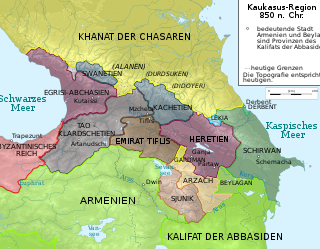
The Kingdom of Hereti was a medieval Georgian monarchy which emerged in Caucasus on the Iberian-Albanian frontier. Nowadays it roughly corresponds to the southeastern corner of Georgia's Kakheti region and a portion of Azerbaijan's northwestern districts.

The shashka or shasqua is a kind of North Caucasian sabre; a single-edged, single-handed, and guardless sabre. The comparatively gentle curve of a shashka blade puts the weapon midway between a typically curved sabre and a straight sword, effective for both cutting and thrusting.

A kalis is a type of Philippine sword. The kalis has a double-edged blade, which is commonly straight from the tip but wavy near the handle. Kalis exists in several variants, either with a fully straight or fully wavy blade. It is similar to the Javanese keris, but differs in that the kalis is a sword, not a dagger. It is much larger than the keris and has a straight or slightly curved hilt, making it a primarily heavy slashing weapon.

The peoples of the Caucasus, or Caucasians, are a diverse group comprising more than 50 ethnic groups throughout the Caucasus.
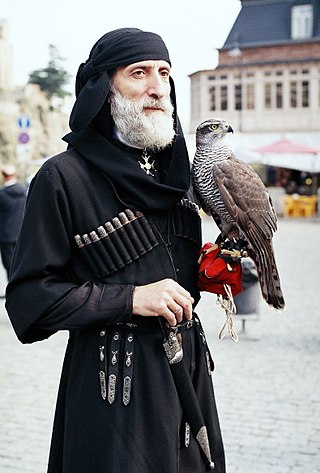
A chokha, also known as a cherkeska, is a Kartvelian woolen coat with a high neck that is part of the traditional male dress of peoples of the Caucasus. It was in wide use among Avars, Eastern Armenians Abazins, Abkhazians, Azerbaijanis, Balkars, Chechens, Circassians, Georgians, Ingush, Karachays, Kumyks, Nogais, Ossetians, Tats, the peoples of Dagestan, as well as Terek, Kuban Cossacks, Kurds from Russian empire who adopted it from the aforementioned peoples.

Signagi or Sighnaghi is a town in Georgia's easternmost region of Kakheti and the administrative center of the Signagi Municipality. Although it is one of Georgia's smallest towns, Signagi serves as a popular tourist destination due to its location at the heart of Georgia's wine-growing regions, as well as its picturesque landscapes, pastel houses and narrow, cobblestone streets. Located on a steep hill, Signagi overlooks the vast Alazani Valley, with the Caucasus Mountains visible at a distance.
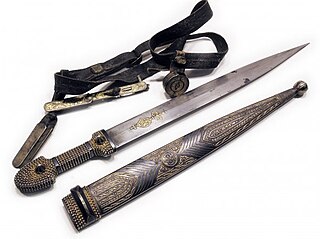
The qama is a short North Caucasian dagger. It has a long wide double-edged blade and is native to the North Caucasus. The qama was also traditionally carried by the Cossacks who adopted it from the peoples of the Caucasus, and is commonly referred to as the "Cossack dagger". It resembles the Roman gladius and Scottish dirk.

Diocese of Baku and Azerbaijan is a diocese of the Russian Orthodox Church in Azerbaijan. Majority of its members are ethnic Russians of Azerbaijan. Entire territory of Azerbaijan is under ecclesiastical jurisdiction of the Russian Orthodox Eparchy of Baku and Azerbaijan, centered in the Holy Myrrhbearers Cathedral in Baku. The Church of Michael Archangel also exist in Baku. Aleksiy Smirnov is the current bishop.
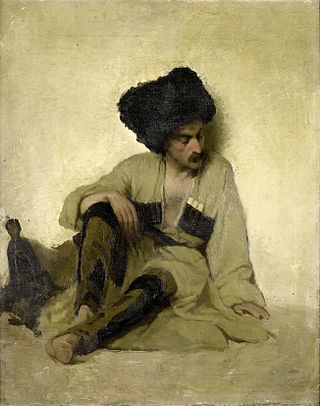
The papakha is a wool hat worn by men throughout the Caucasus and also in uniformed regiments in the region and beyond. The word papakha is of Turkic origin (papakh).

Before the 10th-century unification of the country by the Bagrationi dynasty, several Georgian states subsisted between the Roman Empire on the west and the Sassanid Empire on the east. Between the 11th and 15th centuries, the Kingdom of Georgia was a major regional power which withstood invasions by the Seljuk, Mongol and Timurid Empires before its fragmentation and submission to the Ottoman and Safavid Empires. Many Georgians fought in the armies of empires that ruled the country since the 16th century, be it the Safavids, the Russian Empire or the Soviet Union. Since 1991, independent Georgia has taken part in a number of wars; its conflict with Russia culminated in the 2008 Russo–Georgian War, and its alliance with the United States led to Georgia's participation in the Afghan and Iraq Wars.

The Zakatal okrug was a special administrative district (okrug) of the Caucasus Viceroyalty of the Russian Empire, part of the Tiflis Governorate from 1893 to 1905. The administrative centre of the district was Zakataly, and it corresponded to most of the contemporary districts of Balakan, Zaqatala and Qax of Azerbaijan. The Zakatal okrug was established from the territories of the erstwhile Free Jamaats of Jar-Balakan, bordering the Tiflis Governorate to the west, the Elizavetpol Governorate to the south and the Dagestan Oblast to the north. The district was the smallest independent administrative unit of the Russian Empire, similarly to the Sukhumi okrug.
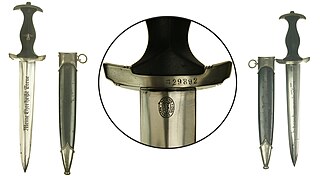
The SS-Ehrendolch was a ceremonial weapon of the Schutzstaffel (SS).

The Turco-Mongol sabre, alternatively known as the Eurasian sabre or nomadic sabre, was a type of sword used by a variety of nomadic peoples of the Eurasian steppes, including Turkic and Mongolic groups, primarily between the 8th and 14th centuries. One of the earliest recorded sabres of this type was recovered from an Avar grave in Romania dating to the mid-7th century.


















